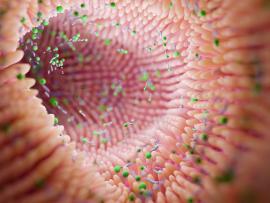Precision-cut intestinal slices create new avenues for allergy research
A research group led by Thomas Eiwegger, MD, Head of the Clinical Department of Pediatrics and Adolescent Medicine at the University Hospital in St. Pölten and Assoc Prof of Karl Landsteiner University and the University of Toronto, is providing new insights into acute food allergies. The researchers published in the "European Journal of Allergy and Clinical Immunology" a new model based on human intestinal tissue samples.
Food allergies affect up to 10% of children in certain areas and are on the rise. Allergen exposure in food-allergic children can result in life-threatening reactions. Given the lack of treatment and markers of food allergy, new models to study mechanisms and new treatment options for food allergy are required.

Diversity of cells is maintainedAfter consumption of an allergen, contact with food allergens usually occurs in the gastrointestinal system. The allergens then interact with the immune system, which is activated in allergic individuals. In the intestine, there are different cells, such as mast cells, immune cells, fibroblasts, epithelial cells, smooth muscle cells and many more. The tissue responds to the mediators released by the immune cells and is crucial for a generalized allergic response. The complex cellular composition of mucosal tissue is not represented in classical cell models or organoids, but is essential for the study of allergic reactions and drug effects. Therefore, Lisa Hung, who generated this model as part of her PhD thesis, used precision-cut intestinal sections (PCIS). By doing so, intestinal tissue is accessible from children as part of operations. It is important that the architecture and composition of immune and stroma cells in the intestine remain unaffected in the precision-cut intestinal slices. These precision-cut intestinal sections have a defined thickness (400µm) and contain all characteristic and cell types of the mucosa and submucosal tissue.
Viability is preservedThe group reported that PCIS remain vital for at least 24 hours. Adding sera from peanut-allergic individuals made the tissue sections "allergic". Contraction of the smooth muscle that occurs in response to the mediators released by immune cells, such as mast cells, was defined as the read-out of an allergic reaction. To measure this, the scientists filmed these muscle contractions in the cell system after adding the allergen and developed special software that allowed the quantification of the response. Various endogenous substances that cause such smooth muscle contractions served as positive controls, while allergens to which the tissues were not made allergic served as negative controls. The measured contraction changes after the addition of the test substrates confirmed that sensitized PCIS react specifically only to the corresponding clinically relevant allergen and not to other foods or substances.
Oral immunotherapy as a promising approachFor a long time, allergy sufferers had to strictly avoid the substances and foods to which they react strictly. Since 2022, oral immunotherapies for food allergies have also been used as routine therapy in Austria. They are exclusively offered in centres with the respective expertise, such as the University Clinics St. Pölten, which is considered a leading centre in this field in Austria. To illustrate the suitability of the PCIS model for studying the regulatory effects of oral immunotherapy, the suppression of allergen-specific responses after successful oral immunotherapy was demonstrated. Scientists also confirmed this for some drugs used in the therapy of allergic diseases. Their model is, therefore, not only able to mimic IgE-mediated food allergies in situ but also offers the possibility to test oral therapeutics in a targeted manner.By realistically reproducing the situation in intestinal tissue, the researchers hope that this model will be a crucial addition to systems for the assessment of new drugs in human tissue before they are evaluated in humans.
Original paperHung L, Celik A, Yin X, Yu K, Berenjy A, Kothari A, et al. Precision cut intestinal slices, a novel model of acute food allergic reactions. Allergy: European Journal of Allergy and Clinical Immunology. 2022.




